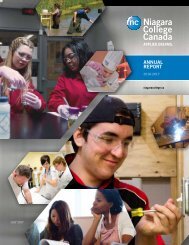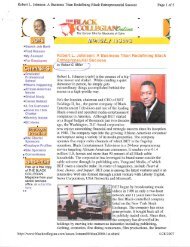annual-report-2016-2017
Create successful ePaper yourself
Turn your PDF publications into a flip-book with our unique Google optimized e-Paper software.
NIAGARA COLLEGE OF APPLIED ARTS AND TECHNOLOGY<br />
Notes to Consolidated Financial Statements<br />
Year ended March 31, <strong>2017</strong><br />
Niagara College of Applied Arts and Technology (the “College”) is an Ontario College established as a<br />
Community College under The Department of Education Act of the Province of Ontario. The College<br />
is a registered charity and is exempt from income taxes under the Income Tax Act.<br />
The consolidated financial statements have been prepared by management in accordance with<br />
Canadian Public Sector Accounting Standards including the 4200 standards for government not-forprofit<br />
organizations.<br />
1. Significant accounting policies and disclosure:<br />
(a) Basis of presentation:<br />
These consolidated financial statements reflect the assets, liabilities, revenues and expenses<br />
of the College, its wholly owned subsidiaries, Niagara College Learning Enterprise Corporation<br />
and Niagara College Foundation. All inter-organization assets, liabilities, revenue and<br />
expenses have been eliminated.<br />
Niagara College KSA is a for-profit subsidiary of Niagara College and Niagara College Learning<br />
Enterprise Corporation, which is accounted for on a modified equity method basis. Information<br />
concerning this entity is presented in note 5 to these financial statements.<br />
(b) Revenue recognition:<br />
The College follows the deferral method of accounting for contributions which include donations<br />
and government grants. Externally restricted contributions are recognized as revenue in the<br />
year in which the related expenses are recognized. Contributions restricted for the purchase<br />
of capital assets are deferred and amortized into revenue on a straight-line basis at a rate<br />
corresponding with the amortization rate for the related capital assets. Unrestricted<br />
contributions are recognized as revenue when received or receivable.<br />
Donations of assets are recorded at fair value when a fair value can be reasonably estimated.<br />
Long-term receivables for capital assets are recorded as an asset in the accompanying<br />
consolidated financial statements when the amount to be received can be reasonably<br />
estimated and collection is reasonably assured. Long-term receivables are commitment from<br />
students for capital assets.<br />
Tuition fees are recognized as revenue when earned through the provision of service. Ancillary<br />
revenue including residence, parking and other sundry revenues are recognized when products<br />
are delivered or services provided to the student or client, the sales price is fixed and<br />
determinable, and collection is reasonably assured.<br />
10




